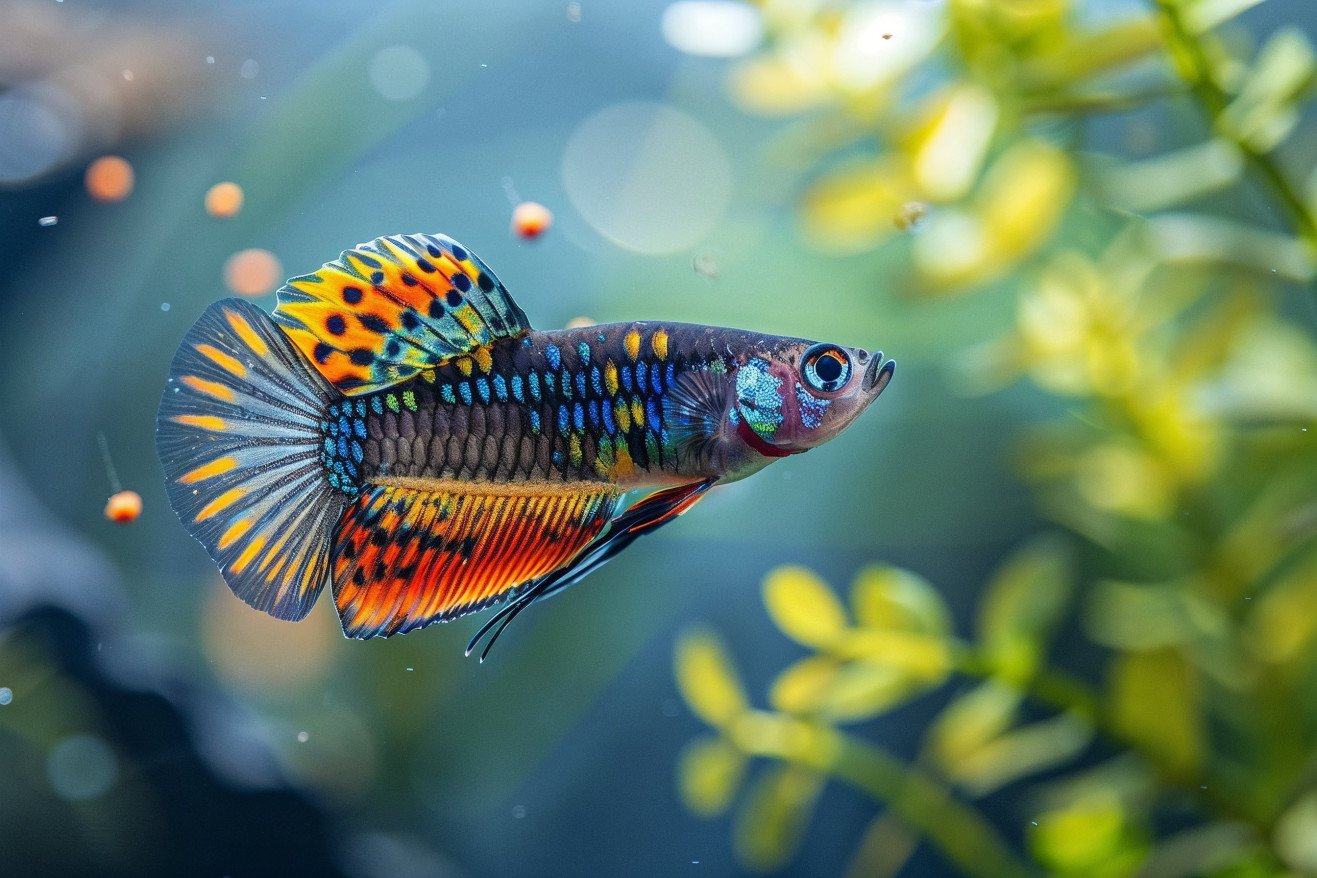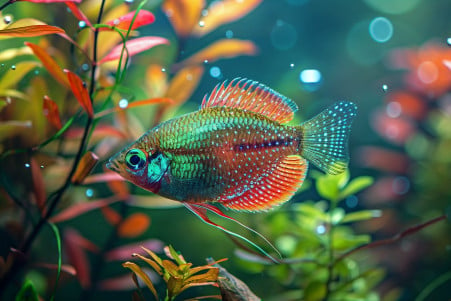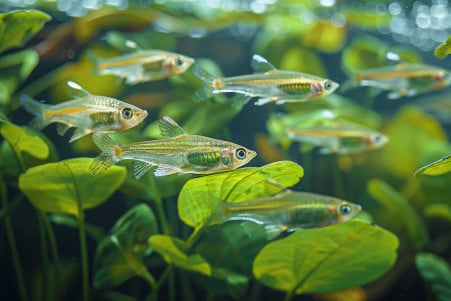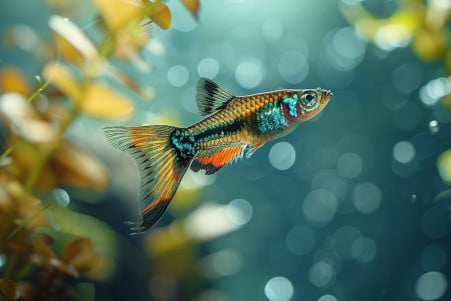What Do Guppies Eat? Exploring the Omnivorous Diet of Guppy Fish
10 March 2024 • Updated 9 March 2024

Guppies may be known for their bright colors, but what kind of diverse palates are hiding behind those neon shades? Guppies are omnivores, which means they eat both plant-based and animal-based foods. In the wild, their diet consists of brine shrimp, invertebrates, and insect larvae. In aquariums, they eat a mix of high-quality flake food, vegetables like peas and zucchini, and the occasional bloodworm.
This article takes a deep dive into the guppy’s diet by looking at a variety of zoological and aquaculture studies that have been done on the fish.
By looking at the results of ecological studies that have been done on guppies in the wild and the lessons learned from studies on guppies in captivity, we can get a more complete picture of the nutritional requirements that influence their eating habits and ensure that we’re providing a well-rounded diet for these active little fish.
What do guppies eat?
Wild Guppies: Diet and the Impact of Predation and Environment
In their highly variable natural environments, guppies (Poecilia reticulata) are highly adaptable in their diets, eating a combination of live foods like brine shrimp and insect larvae and plant-based foods like algae.
A study in Functional Ecology shows that predation has a major impact on guppy feeding behavior and diet. Guppies from high-predation (HP) populations are more likely to mature faster and have more offspring, and they prefer invertebrates that are more nutritious. On the other hand, guppies from low-predation (LP) populations eat more detritus and algae, which are less nutritious.
Ecological factors like light and primary productivity, which were studied in The American Naturalist, are also important because they determine the availability of these food sources. HP populations live in larger streams with more light and productivity, so they have more access to nutritious food.
Interestingly, the predation regime has an indirect effect on guppy foraging because it determines the density of the guppies’ prey populations, which, in turn, influences the guppies’ preference for certain prey and their strategies for getting nutrients from their food.
This complex web of interactions in the wild helps us understand the full range of guppies’ dietary needs, which can then be used to make sure guppies are fed properly in captivity.
Feeding Your Guppy: A Comprehensive Guide to Feeding in Captivity
Guppies in captivity thrive on a diet that is as close to the one they would have in the wild as possible. According to wikiHow, the best way to do this is to make sure that the staple of their diet is high-quality tropical fish flake food that has been fortified with both protein and vegetable matter.
Feeding guppies a small pinch of this flake food once or twice a day, with a 12-hour gap in between, is the best way to make sure that they are eating in a way that is similar to their natural habits.
When it comes to feeding guppy fry, the most important thing is to make sure that they are being fed often. This is because they can only eat a little bit at a time. However, FishLab warns that guppy owners often overfeed their fish, which can lead to problems like tank pollution and health issues for the fish.
The best way to make sure that you are feeding your guppies the right amount is to watch them eat. They should be able to eat all of the food that you give them in about five minutes.
It’s also important to make sure that you are adding variety to their diet by feeding them vegetables and live foods like brine shrimp and daphnia. For example, blanched vegetables are recommended because they will make sure that the guppies get the nutrients that they need without causing them to have digestive issues.
Overall, making sure that you are feeding your guppies a balanced diet means that you are giving them the nutrients that they need in a way that is appropriate for their size, life stage, and natural habits, which will help them thrive and be as healthy and colorful as possible.
Putting Together the Pieces: What Guppies Need to Eat
Guppies require a well-rounded diet that includes a variety of nutrients, each of which is important for different aspects of their health. For example, FishLab notes that proteins are needed for tissue repair and immune function, while carbohydrates are used to fuel guppies’ constant activity. Meanwhile, vitamins A, C, and E, and minerals like calcium and phosphorus are all important for maintaining guppies’ vision, skin, and skeletal health.
The balance of nutrients in a guppy’s diet has a direct impact on their physiology. A study in PLoS One by Christopher M. Dalton and colleagues found that the quality of a guppy’s diet influenced the way they absorbed and excreted nutrients.
The researchers showed that guppies can change their whole-body nutrient content in response to dietary phosphorus levels, a change that has a significant impact on their growth and reproductive success.
In order to ensure that guppies get the nutrients they need, it’s important to feed them a varied diet that includes protein-rich foods like brine shrimp and daphnia and fiber-rich foods like vegetables. Not only will this help guppies meet their nutritional needs, but it will also help them maintain their bodily functions and keep their colors bright and vibrant, setting the stage for future studies of their foraging behaviors and food preferences.
Guppy Foraging: A Study of Behavior and Adaptation
Guppies in the wild exhibit complex foraging behaviors that are shaped by the availability of resources and the presence of predators. For example, the study “Food and feeding behavior of the guppy, Poecilia reticulata (Pisces: Poeciliidae),” by Gertrude V. Dussault shows that guppies use a series of rapid pecks to feed on benthic algae, and that their rate of ingestion increases with food density and fish size.
However, the presence of predators changes these patterns, leading guppies to modify their feeding behaviors in ways that will help them avoid being eaten.
A study in Biology Letters by Amina Mohamed demonstrates that guppies can change their dietary preferences in a matter of a few generations in response to environmental factors like predation and competition. This rapid evolution is an example of the guppies’ impressive ability to adapt to changes in their environment.
In addition, a study in ScienceDirect shows that guppies have inhibitory control, which means they can learn to suppress their natural foraging behaviors. This cognitive flexibility, which also includes the ability to remember past experiences to avoid repeating the same mistakes, can impact how guppies are fed in captivity, where the lack of predators and regular feeding schedules mean that a different approach is needed to ensure their health.
Knowing about guppies’ natural and evolved feeding behaviors underscores the need to create an environment in captivity that includes the same kind of variety and challenges to ensure the health and longevity of captive guppies.
How to Choose the Best Commercial Food for Your Guppy
When looking at the many options available for commercial guppy food, it’s important to find the ones that best meet the needs of your fish. As The Aqua Advisor points out, the quality of the ingredients in the food you choose is important for your guppy’s overall health, growth, and color.
Guppy food generally comes in the form of pellets, flakes, freeze-dried, and live food, and all of these options should be high in protein for growth and carotenoids for color.
The Aquarium Life suggests looking for pellet foods, which often contain nutrient-rich ingredients like spirulina, algae, and plankton, all of which are full of essential vitamins and minerals that are important for guppy health. In addition, wet foods, like frozen or live bloodworms and brine shrimp, are a good source of fatty acids and amino acids that dry foods don’t always have.
Flake foods, which are also popular, should be chosen based on the variety of nutrients they contain. However, according to research by Hikari, the quality of the nutrients in the food and how well they’re retained is just as important, as it can affect a guppy’s immune system and coloration. Hikari has taken this into account in the development of products like its Tropical Fancy Guppy.
When choosing commercial food, it’s also important to look at the sustainability of the brand. This can be seen in the packaging that the food comes in and can make a difference in the choices that consumers make.
By making sure that you’re feeding your guppy a mix of these different kinds of food and taking sustainability into account, you can help ensure that your guppy has the best chance at a healthy, colorful life.
In Conclusion: What to Feed Your Guppies for a Long, Happy Life
Throughout this article, we’ve discussed the ins and outs of guppy nutrition, from their omnivorous tendencies to their feeding habits in the wild and in captivity. We’ve also learned about the importance of essential nutrients—proteins, vitamins, and minerals—and how they help guppies grow and reproduce.
We’ve also seen how guppy feeding behavior in the wild, which is affected by the presence of predators and food availability, impacts their behavior in aquariums. It’s clear that feeding guppies a balanced diet goes beyond just putting food in a tank; it also requires understanding and respecting the fish’s natural instincts and needs.
This means that guppy owners not only have a responsibility to feed their fish a healthy diet, but also have the chance to see the positive results of good care. While commercial foods are convenient, it’s up to us to make sure that we’re choosing foods that meet the specific needs of our guppies’ active lives.
As we wrap up, we hope that this article encourages you to learn more about guppy nutrition and care. By continuing to learn and take care of them in the best way possible, we can ensure that our guppies live long, happy lives.


